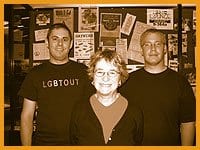Fresh-faced frosh and long-time homophiles alike are invited to breeze by Robarts Library on U of T’s downtown campus to take in Proud Past: U Of T’s Queer History, an exhibit marking the 35th anniversary of the campus queer group.
“I think it’s important for students to see what’s changed and what hasn’t changed,” says Paul Bowser, graduate student and former coordinator of Lesbians Gays Bisexuals And Transgendered Of U Of T (LGBTOUT). “It doesn’t take long for things to become lost in the past.”
Unfortunately, one aspect of queer activism on campus hasn’t changed. “It seems anytime there’s any sort of queer visibility on campus a backlash inevitably follows,” says Bowser. In this case, the exhibit was vandalized within days of completion with posters that read “Back to the closet.”
“It’s not totally unexpected,” says Bowser. “But, yes, we were surprised.”
Proud Past is a joint project of LGBTOUT and the university’s Sexual Diversity Studies (SDS) department. It’s been in the works since July, when Bowser, SDS director Maureen FitzGerald and Paul Morrison, a fourth year computer science and psychology student who has spent the last two years researching queer history on campus, started compiling the results of Morrison’s research with the help of Casey Sobawi, a student at U of T’s Scarborough campus. The exhibit also received support from the university’s Office Of LGBTQ Resources And Programs and the Michael Lynch Fund.
U of T’s gay activism began with an ad placed in the Oct 15, 1969 issue of U of T newspaper The Varsity seeking “anyone interested in discussing the establishment of a student homophile association.” Fifteen people showed up at the group’s first meeting and two weeks later the Students’ Administrative Council recognized the University Of Toronto Homophile Association (UTHA) as an official organization. Jearld Moldenhauer, Charlie Hill, Ian Young and Disa Rosen (soon replaced by Bill McRae) comprised the first executive.
UTHA was the first queer group in Toronto and the first queer student group in the country. It lapsed between ’73 and ’77, and then reemerged as Gays At University of Toronto (GAUT). Bit by bit over the years the moniker has become more inclusive of other queer identities.
The exhibit is divided into several sections spanning the early years of out homos on campus up to the present day. Among the older relics are notes from an early UTHA planning meeting in October 1969 and a poster for a Dance Your Ass Off fund-raiser from the early ’70s.
The display also includes a timeline, beginning with a 1955 article from the campus newspaper the Varsity about men cruising Philosopher’s Walk, a treed walkway between the Royal Conservatory Of Music and the Royal Ontario Museum that runs from Bloor to Wellesley.
In recognition of the academic contributions U of T faculty have made to queer history and theory over the years there is a case titled Queer Profs/Queer Books, featuring a selection of titles including Dykewords: An Anthology Of Lesbian Writing and John Allan Lee’s Getting Sex: A New Approach: More Fun, Less Guilt. There’s a particular emphasis on two professors, Michael Lynch and Bill Lewis, for their contributions both as academics and as activists. Memoirs by and about campus rabble-rousers such as Dan Healy and Luanne Karn are displayed in the Student Voices section, which Bowser would like to see it become an ongoing on-line project.
Morrison says he hopes today’s queer scholars will take away from the exhibit “a sense of what has gone before” and that it will remind people that they need to be more mindful about donating to queer archives. “I think a lot of people don’t know the context of how the rights and freedoms we enjoy now came about.”
* Proud Past: U Of T’s Queer History will be on display on the second floor of Robarts Library (130 St George St) until the end of the month before moving to Scarborough campus for October. It will return to Robarts for the month of November; a public reception is currently in the works for that time.

 Why you can trust Xtra
Why you can trust Xtra


